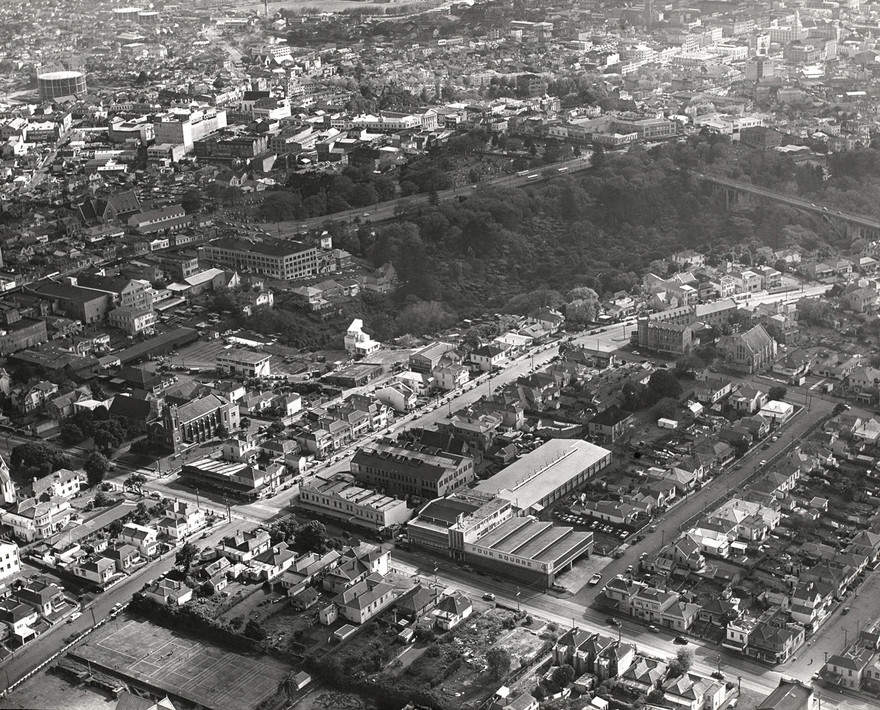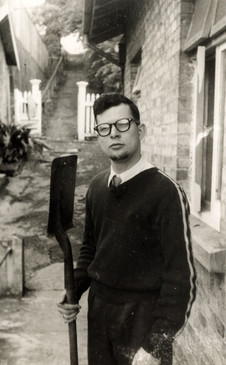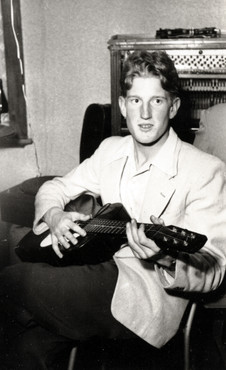Many years ago – in the 1940s and ’50s – when Auckland’s central city was much more laid back and less intense, when a major news item would cover when the trams stopped running, there was a musicians’ pad where the residents established a special lifestyle, with much music, carousing, wild oats, and simply growing up before migrating later into more sedate and arguably more boring living.
There were other contemporary living quarters, or hell-holes (depending on the viewpoint) such as at Ring Terrace and The Hall, but 57a Symonds Street is still remembered by a great number of musicians.
There are many stories about 57a, and these are some of them. They are all based on fact, and the musicians’ names are real. One or two other names may have been changed to protect the guilty.
I hope you enjoy this little book and perhaps stir one or two memories. – Bennie Gunn, August, 1993

Grafton, Newton, and Auckland's CBD, April 1956. Symonds Street runs above the Grafton gully bush, with 57a just north of the bridge. - Auckland Libraries Heritage Collections, 580-ALB22-180
1 – A Brief History of 57a
Tucked away down a straight steep path just below Symonds Street – a little south of the top of Airedale Street – was a house, unobtrusive and plain in character. Surrounded by the Marinoto health clinic, a Masonic lodge, and a few unremarkable office buildings and boarding houses, its nearest landmark was the now long-gone Partington’s Mill. But in the late 1940s the house became well known to the musical segment of society, almost from the time when the first musicians moved in to begin its history as a muso’s pad.
The house itself had been a brick family bungalow, adapted by the landlord to yield the maximum number of bedrooms (and income) by deleting such unnecessary luxuries as living and dining rooms and kitchen, and installing a gas ring in each bedroom to provide the bare necessities. The only service room contained the bath and toilet, and was presided over by a fearsome and moody gas caliphont. There were five bedrooms in the house, with further accommodation in a brick outhouse (once a laundry), and under duress in the basement which was subject to flooding after severe rainfall.

Art Rosoman playing saxophone with the Lauri Paddi Band in the 1940s. - Alexander Turnbull Library, Wellington. Ref: PA1-q-182-12-2
Among the first to occupy 57a were Bob Taggart (clarinet and saxophone), at that time a teenager, Mark and Tom Kahi (guitarists), who lived there some time before moving to another renowned pad in Carlton Gore Road, The Hall, Derek Heine (clarinet), Art Rosoman (tenor sax), Tarz Martin (bass). Other early residents were Lyn Christie (bass and trumpet), Dave “Dreamboat” Ironsides (trumpet) and his brother Red, Neil Dunningham (trombone), Loma Saunders (vocalist), and Pem Sheppard (alto sax and clarinet).
Later residents were Lachie Jamieson (drums), Val “Choc” Leemon (piano), Bennie Gunn (piano, guitar, arranger), Bernie Allen (tenor sax, clarinet, flute, arranger) and his new wife Bonnie, Merv Thomas (trombone) and his wife Carol, Maurie Smith (sax), Pete Robson (alto sax), Tony Baker (alto sax and clarinet) and Brian Fagan (bass).

Bernie Allen does the spade work at 57a Symonds Street, late 1950s. - Bernie Allen Collection
The longest-lasting non-musician was resident drunk Old George Peterson; others were Gibbo, Amy and Ken Badger, the boxer and carpenter. This list is not exhaustive, nor does it include the many who used the place as a brief crash-pad, nor the musicians’ companions who came and went. An enduring advantage of 57a was its distance from other houses. Even Mike Williams, the trumpeter who lodged in a boarding house at the top of the path, was only dimly aware of even the wildest parties going on down below.
The Sussex family who owned the house has, as survivors today (1993), sons of the landlord: Morrison Sussex (owner of a former menswear shop in Newmarket) and George Sussex (who owns a menswear shop in Orewa). Both remember visiting 57a with their father, as small boys. As the 1950s passed, the surrounding area became more highly developed, the house more dilapidated and – with its long grass and rank natural wild trees and shrubs – less in keeping with the sophisticated buildings going up around it.
An enduring advantage of 57a was its distance from other houses
The later residents succumbed to marriage, Old George to the booze, Pete Robson to the lights of London, and when the last occupant had moved out, Mr Sussex received an offer he couldn’t refuse, from Marinoto the next-door children’s health clinic, who painted the place up and used it as a storage warehouse. It again became quiet and respectable, as it must have been in the years before the first musician moved in, and remained so for another 25 years from the time it ceased to be a musicians’ hangout.
Finally, it too succumbed to progress and was demolished. Today, tall mirror glass walls and concrete dominate the area. A radio station on the seventh floor of the building which straddles the old house site broadcasts regular jazz programmes, but that station too is changing hands, leaving as the only link with the past the two tall oak trees which once marked the corners of the garden wilderness in front of the house.
2 – The Early Days
In the beginning was Mrs Taggart, who took out a five-year lease on 57a and installed the first musicians in what was intended to be an orderly and well-run house. These included Tom and Mark Kahi, and of course her teenage son Bob. She was a diminutive Scots woman who liked to be reassured that her son did indeed have musical talent, and surrounded him with more musicians. The included expat-Canadian saxophonist Art Rosoman, who had been band leader at the Peter Pan then the Metropole Cabaret during the late 1940s, with pianist Nancy Harrie and vocalists Coral Cummins and Esme Stephens; Derek Heine the clarinettist who modelled himself on the then perennial favourite Artie Shaw; and Tarz Martin the bass player. They were soon joined by Neil Dunningham the trombonist, and the three of them played at the Peter Pan Cabaret together. Their vocalist, Loma Saunders, moved into 57a as well. “Dreamboat” (Dave Ironsides) shifted into the corner room with his brother Red and lifted the partying stakes a notch or two.
Naturally, there were many other musicians and friends dropping in all the time. The Peter Pan, in those days of six-o’clock closing, was one of the few places where people could socialise: even there, liquor had to be surreptitiously smuggled in bottles disguised as soft drinks or in brown paper bags, and hidden in ladies’ handbags, and once inside, concealed on the floor under the table. The heady freedom of frequent parties at 57a, with the grog limited only by the funds available – no worry about noise, and no shortage of pleasant and compliant companions – was like a magnet to the music set.
Other similar hang-outs sprang up to meet the pent-up demand: The Hall, in Carlton Gore Rd, established by Frank Stockton and Dick Hobday who were joined by Mark and Tom Kahi after they moved from 57a; and the “Edinburgh Castle,” not the pub but the house in Edinburgh Street, Newton, occupied by pianist Laurie Comnee which became the scene of endless parties downstairs and endless activities upstairs. Laurie often tried to escape the tumult by coming down to 57a and sleeping on the floor, but peace and quiet there could hardly have been much better.

Mark Kahi at the Hi Diddle Griddle, K Road, Auckland, 1959
Mark and Tom Kahi considered themselves handy with their hands, and having no money to splash out on a boat, they decided to build one themselves, in the basement. After much sweat and toil, and delays while the money for materials was scraped together, the boat gradually took shape until many weeks later their proud creation was ready to be unveiled.
Their careful measurements which led to the pleasing proportions and even curves of the hull had not extended to the door of the house however, because to their consternation they found there was no way they could get the finished boat out of the basement. In there it remained, as a kind of memorial while the arguments raged on.
Mrs Taggart’s efforts to maintain an uplifting environment and correct behaviour at 57a in keeping with the mores of the day must have been as difficult and fruitless as the task of Mr Sussex, the landlord and self-appointed moral guardian, who took over in later years when Mrs Taggart’s lease had expired.
3 – Mr Sussex, the Genial Landlord
The smiling countenance of Mr Sussex was to be seen at 57a each time the rent was due, every Thursday afternoon. His small stature was more than compensated by his beaming smile and cheery greeting, for Mr Sussex had infinite faith in human nature, and believed there was good in everyone, even musicians. Whenever a new tenant moved in, Mr Sussex made sure that a Bible and several uplifting little booklets were left in a chest of drawers. If he was disappointed at the very poor rate of spiritual rehabilitation of his tenants, he never showed it, as long as he succeeded in the almost equally difficult job of collecting all of the rent from each of them. After a business lifetime of office administration, he was considered by his family members, who owned the house, to be best fitted to deal with the tenants, especially the musicians, even if this demanded a ritual visit each week on rent day. In fact, apart from the two small sons he occasionally brought with him, none of the rest of his family would dream of setting foot in the place.
As long as musicians with their nocturnal habits shared the house with non-musicians who got up in the morning and went to work, there was bound to be friction. When this reached the stage of bitter complaints, Mr Sussex would arrive, even late at night if called, to mediate with his oft-expressed philosophy that “everyone should have a fair pop.” Even so, he was ill-prepared with his background in the Scriptures, to admit the existence of the strange lifestyle he encountered at 57a, and preferred to believe he must have imagined it.
Val “Chocolate” Leemon, the pianist, lived in the corner room, the largest in the house. The room next to him was occupied by drummer Lachie Jamieson, until he moved out after marrying Rhonda. Because of its size and its cooking facilities (there was no kitchen in the house) Choc’s room was frequently used as a communal living room and a party venue.

Bennie Gunn on guitar, 1950s. - Bennie Gunn Collection
Bennie Gunn, another pianist, lived in the room next door on the other side, and was in the throes of starting a manufacturing business, using a table in the corner opposite his bed as a workbench to make amplifiers for guitars and sound systems. While this was later to grow into a full factory operation elsewhere – making well over 1000 Concord amplifiers and guitars a year during the rock’n’roll era and employing an assembly staff (including Jan Kessell and Glyn Tucker) – at that time he was struggling to finance the purchase of enough components to make his first public address amplifier to install in Bob Sell’s new restaurant, La Boheme.
Therefore to Bennie, paying the rent that day was a crisis he could do without and, on hearing Mr Sussex’s cheery greeting in the hall, promptly disappeared into Choc’s room. “Got room in your wardrobe?” he asked Choc. “You know who’s out there.”
“Haw Haw!” responded Choc. “Hop in – I haven’t seen you!” “Thanks,” said Bennie. “’Scuse me while I disappear!” Drawing a blank at Bennie’s room, Mr Sussex knocked on Choc’s door. “Lovely to see you, Mr Leemon! Have you got this week’s rent for me?”
As Choc handed him the rent, Mr Sussex spoke reflectively, some sixth sense at work. “What a shame Mr Gunn is not in – I’m sorry to have missed him. However, there’s one door here I haven’t tried!”
He stepped over to the wardrobe, knocked on the door, then turned the handle and swung it open. Surrounded by Choc’s shirts and suits, Bennie stared dumbfounded as Mr Sussex beamed at him.
“Ah, there you are, Mr Gunn – so I didn’t miss you after all – so nice to see you! Now that you’re here, you’ll be wanting to give me the rent!”
Bennie sheepishly stepped out of the wardrobe and paid up, after which Mr Sussex, with a full bag, cheerily went on his way until the inevitable visit next rent day.
Eventually, the stress on the non-musicians was too much, and they either left or died
Eventually, the stress on the non-musicians was too much, and they either left or died. There were no more battles for Mr Sussex to mediate, but his task of collecting the rent was harder. One rent day, he was uncharacteristically despondent.
“The family is worried about this place,” he confided to Bennie. “With rising expenses, it’s just not what it was. We’re even thinking of selling it.” He paused and stared gloomily at the overgrown yard. “Unless we put the rent way up.” “There’s no need to do that, Mr Sussex,” responded Bennie. “If you really want to sell, I might be able to find a buyer.” “Really?” Mr Sussex brightened perceptibly. “Do you really have someone in mind?” “Certainly do!”
“Well! In that case, I’ll leave things as they are until something eventuates.”
There was some discussion later among the musicians about buying the house, but on adding together all the meagre funds available, it was quickly apparent the idea would never fly. With growing disappointment, Mr Sussex learned on each subsequent visit that the mystery buyer had not yet made his bid. But by the time he eventually lost hope, the momentum for selling the place had quite dissipated.
4 – Getting Shot of the Rats
The most peaceful time of day in the summer was the early evening, when sitting in the porch with a beer during the long twilight was a good excuse for a yarn. Choc, a reluctant accountant by day, came home from his auditing work with Chambers, Worth & Chambers in need of relaxation, and could be found on the porch many evenings with whoever was available.
One day, when he and Bennie were enjoying the lengthening shadows across the long grass yard to the bush (the peace at 57a was never disturbed by lawnmowers), their idyll was rudely disturbed by a huge rat leaping into the incinerator 25 feet away.
“Where the hell did that come from!” yelled Choc incredulously, dashing into the grass. The rat leapt out and beat a hasty retreat – it seemed the size of a small cat.
Quite often food scraps were tossed into the incinerator to avoid having to frequently drag the rubbish bin up the steep path to the street above, but the connection between this and the rat never occurred to anyone.
“I’ve got an old air rifle somewhere,” said Bennie quietly. “I’m sure I could get it going and knock that bastard off.”
When the War of the Rats was declared, Bennie came home to 57a and grabbed the air rifle
The following day with the now-working air rifle and a tin of slugs and a few bottles of beer, they settled down to wait. After nearly an hour, the rat appeared, but in the excitement the shot went wild. A little target practice was obviously needed. So a cardboard target ring was constructed and pinned to the dunny door at the end of the passage, so a marksman could sit in the hallway and fire away in comfort.
Shortly after the War of the Rats was declared, Bennie came home at tea-time, grabbed the air rifle and sat down for some practice. After one slug went wildly low, there was a scream from behind the dunny door, and a female began yelling her head off. Choc’s door flew open, and he came out, shouting “That’s Ruby!”
“Ruby? Where?” asked Bennie, flabbergasted. He didn’t know Choc’s current girl-friend was even in the house. “In the bloody dunny, of course!” said Choc, dashing up and banging on the door. Once he got in, he found that a slug had gone under the door, ricocheted off the floor and embedded itself in Ruby’s leg. By the time he dragged her out, she was so wild and embarrassed that there was no way anyone at 57a was going to be allowed to fix her, so Choc had to take her up to the hospital to have the slug removed.
Long after, when the chastened Choc got back, he needed several gins to recover. The hardest part was not patching up Ruby, nor even restoring her wounded pride, but explaining the affair to the incredulous hospital staff and persuading them not to call in the police. Strangely, Ruby’s visits to 57a tailed off remarkably after that little incident. The cause of the whole thing, the rats in the yard, got off Scot-free. Despite numerous tries, none were ever hit, or if they were, they simply shrugged it off.
--
The first of three parts. Part 2: Badger the Boxer ... the Urban Lifestyle ... the Not-So-Gentle Art of Music Teaching